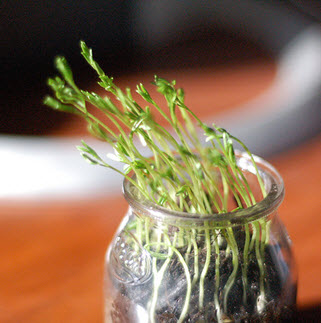Hormonal control in plants
 How do plants respond to light if they don't have eyes nor a brain? The mechanism is quite complex but it is a good illustration of the role of membrane proteins and the fluid nature of the plasma membrane. There are two activities in this lesson, the first is a set of slides with some questions and the second is a very short video clip followed by some more questions. There are model answers provided for both sets of questions.
How do plants respond to light if they don't have eyes nor a brain? The mechanism is quite complex but it is a good illustration of the role of membrane proteins and the fluid nature of the plasma membrane. There are two activities in this lesson, the first is a set of slides with some questions and the second is a very short video clip followed by some more questions. There are model answers provided for both sets of questions.
Lesson Description
Guiding Questions
- How are plants sensitive to the environment, ie: to light ?
- Without a circulatory system how do plants transport hormones to target cells / tissues?
- How can a chemical (like Auxin) affect the behaviour of a cell?
Activity 1: Plant shoot responses to light and gravity
Try this excellent interactive web page on Auxin and plant responses if you are not familiar with tropisms already.
Look at the following slides ![]() Phototropism and auxin efflux pumps and answer the questions below.
Phototropism and auxin efflux pumps and answer the questions below.
Answer the following questions about the slides above.
- Name the plant hormone which is responsible for phototropic responses in plants
- Where is this hormone produced?
- What effect does this hormone have on cells in the shoot?
- What is the affect of light on the location of this hormone?
- How do protein pumps in the cell membranes of cells of the shoot control the movement of the hormone?
Model answers to the questions above.
- Name the plant hormone which is responsible for phototropic responses in plants
Auxin - Where is this hormone produced?
In the tip of the shoot, in the apical meristem - What effect does this hormone have on cells in the shoot?
Auxin causes the cells to elongate, (it has other functions too, eg. promoting the formation of leaves, inhibiting lateral bud formations and causing apical dominance) - What is the affect of light on the location of this hormone?
Auxin accumulates on the shady side of a shoot. - How do protein pumps in the cell membranes of cells of the shoot control the movement of the hormone?
Protein pumps (auxin efflux pumps) in the cell membrane are positioned on the shady side of each cell in the shoot. They pump auxin out of the cell on the shady side which moves the auxin to the shady side of the shoot.
Activity 2: Auxin, growth rates and gene expression
Many auxin effects occur by changes in the transcription of genes.
This happens in a series of steps:
- Auxin enters the nucleus of a cell and
- binds to a receptor protein.
- This causes an inhibitor to stop inhibiting the promoter region of the gene
- The promoter region of a gene is turned on by auxin.
- Gene transcription begins.
Watch this short video ![]() Gene activation by the hormone auxin and then answer the questions below.
Gene activation by the hormone auxin and then answer the questions below.
Answer the following questions about the slides above.
- What are the two parts found in an auxin regulated gene?
- When auxin is present in the cell nucleus what does this do the the transcription factor?
- Why is this described as a double negative mechanism?
Model answers to the questions above.
- What are the two parts found in an auxin regulated gene?
The promoter region, and the gene itself - When auxin is present in the cell nucleus what does this do the the transcription factor?
Auxin causes the release of the transcription factor from an inhibitor. - Why is this described as a double negative mechanism?
Auxin inhibits the inhibitor of the gene's transcription factor.
Two inhibitors of a gene is like a double negative and the result switches on the gene.
Teachers notes
This lesson assumes some basic knowledge of phototropisms and plant responses to light and gravity. It would be an excellent idea to set up some seeds to germinate about a week before this lesson so that students could see the effects. Use of a 'phototropism box' of some sort would be great, and a clinostat experiment would also help to show that it was not just light which plants respond to.
Activity one is a simple set of slides which aim to help an explanation of the role of protein pumps in the movement of auxin in a plant. These details are not commonly found in textbooks whereas the essentials of phototropism and auxin usually are and students who have not seen this before could be guided to read a few pages of a text book. There is also a good summary of early experiments on auxins and phototropism here.
There are clear links in activity 2 to the control of gene expression in the genetics topic.
There are some good summary notes about the role of auxin in plants on this Bristol university website.

 IB Docs (2) Team
IB Docs (2) Team
